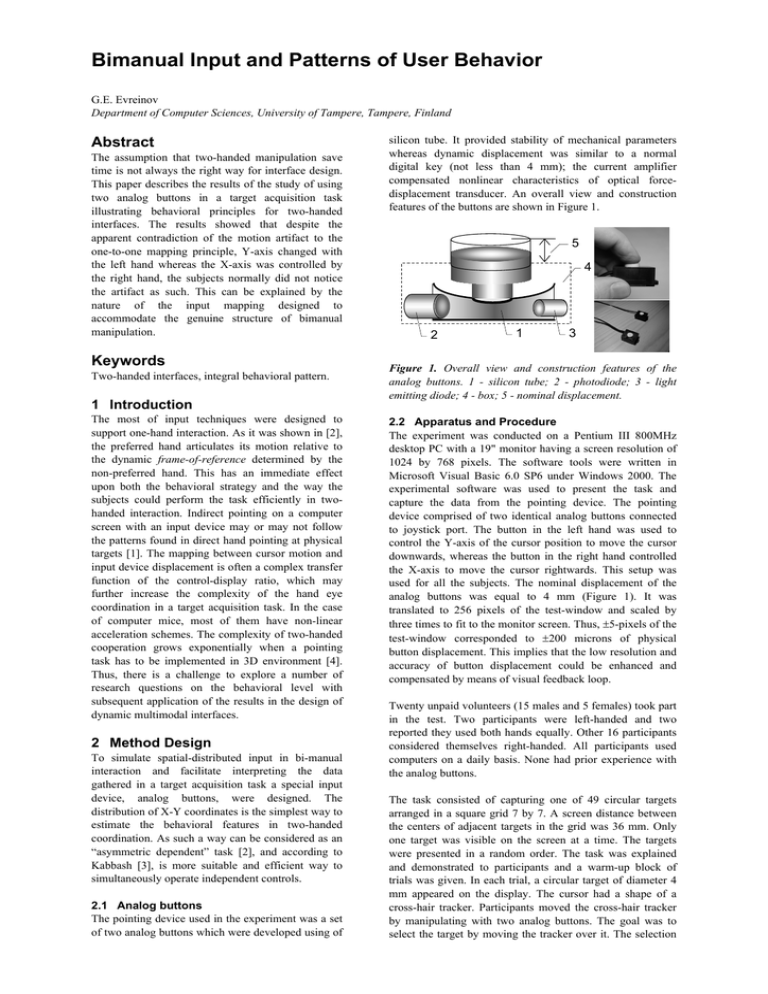Bimanual Input and Patterns of User Behavior
advertisement

Bimanual Input and Patterns of User Behavior G.E. Evreinov Department of Computer Sciences, University of Tampere, Tampere, Finland Abstract The assumption that two-handed manipulation save time is not always the right way for interface design. This paper describes the results of the study of using two analog buttons in a target acquisition task illustrating behavioral principles for two-handed interfaces. The results showed that despite the apparent contradiction of the motion artifact to the one-to-one mapping principle, Y-axis changed with the left hand whereas the X-axis was controlled by the right hand, the subjects normally did not notice the artifact as such. This can be explained by the nature of the input mapping designed to accommodate the genuine structure of bimanual manipulation. Keywords Two-handed interfaces, integral behavioral pattern. 1 Introduction The most of input techniques were designed to support one-hand interaction. As it was shown in [2], the preferred hand articulates its motion relative to the dynamic frame-of-reference determined by the non-preferred hand. This has an immediate effect upon both the behavioral strategy and the way the subjects could perform the task efficiently in twohanded interaction. Indirect pointing on a computer screen with an input device may or may not follow the patterns found in direct hand pointing at physical targets [1]. The mapping between cursor motion and input device displacement is often a complex transfer function of the control-display ratio, which may further increase the complexity of the hand eye coordination in a target acquisition task. In the case of computer mice, most of them have non-linear acceleration schemes. The complexity of two-handed cooperation grows exponentially when a pointing task has to be implemented in 3D environment [4]. Thus, there is a challenge to explore a number of research questions on the behavioral level with subsequent application of the results in the design of dynamic multimodal interfaces. 2 Method Design To simulate spatial-distributed input in bi-manual interaction and facilitate interpreting the data gathered in a target acquisition task a special input device, analog buttons, were designed. The distribution of X-Y coordinates is the simplest way to estimate the behavioral features in two-handed coordination. As such a way can be considered as an “asymmetric dependent” task [2], and according to Kabbash [3], is more suitable and efficient way to simultaneously operate independent controls. 2.1 Analog buttons The pointing device used in the experiment was a set of two analog buttons which were developed using of silicon tube. It provided stability of mechanical parameters whereas dynamic displacement was similar to a normal digital key (not less than 4 mm); the current amplifier compensated nonlinear characteristics of optical forcedisplacement transducer. An overall view and construction features of the buttons are shown in Figure 1. 5 4 2 1 3 Figure 1. Overall view and construction features of the analog buttons. 1 - silicon tube; 2 - photodiode; 3 - light emitting diode; 4 - box; 5 - nominal displacement. 2.2 Apparatus and Procedure The experiment was conducted on a Pentium III 800MHz desktop PC with a 19" monitor having a screen resolution of 1024 by 768 pixels. The software tools were written in Microsoft Visual Basic 6.0 SP6 under Windows 2000. The experimental software was used to present the task and capture the data from the pointing device. The pointing device comprised of two identical analog buttons connected to joystick port. The button in the left hand was used to control the Y-axis of the cursor position to move the cursor downwards, whereas the button in the right hand controlled the X-axis to move the cursor rightwards. This setup was used for all the subjects. The nominal displacement of the analog buttons was equal to 4 mm (Figure 1). It was translated to 256 pixels of the test-window and scaled by three times to fit to the monitor screen. Thus, ±5-pixels of the test-window corresponded to ±200 microns of physical button displacement. This implies that the low resolution and accuracy of button displacement could be enhanced and compensated by means of visual feedback loop. Twenty unpaid volunteers (15 males and 5 females) took part in the test. Two participants were left-handed and two reported they used both hands equally. Other 16 participants considered themselves right-handed. All participants used computers on a daily basis. None had prior experience with the analog buttons. The task consisted of capturing one of 49 circular targets arranged in a square grid 7 by 7. A screen distance between the centers of adjacent targets in the grid was 36 mm. Only one target was visible on the screen at a time. The targets were presented in a random order. The task was explained and demonstrated to participants and a warm-up block of trials was given. In each trial, a circular target of diameter 4 mm appeared on the display. The cursor had a shape of a cross-hair tracker. Participants moved the cross-hair tracker by manipulating with two analog buttons. The goal was to select the target by moving the tracker over it. The selection 3 Results and Conclusion The results showed that despite the apparent contradiction of the motion artifact with the spatialdistributed input to the one-to-one mapping principle, the subjects normally did not notice the artifact as such. This can be explained by the nature of the input mapping designed to accommodate the genuine structure of bimanual manipulation. along the dimension controlled by the dominant hand. The second phase is the closed-loop phase during which the subjects manipulate the buttons to get the cursor over the target. When either of the coordinates gets as close to the target as 6 pixels away from its center, the third phase begins, the final target acquisition phase. During this phase, the other coordinate should be caught up, so that the cursor finally gets over the target. X-axis Y-axis 160 Distance to target, pxls occurred only when the tracker remained within the target area for an uninterrupted period of 300 ms (dwell time). Only one trial was performed on each target, so the session consisted of 49 trials. In each trial, participants were given a limit of 10 seconds to complete selection of the target. If they did not acquire the target within the time limit, an error was recorded for the trial. An error was accompanied by a negative sound beep. The next target was presented after a delay of 1 second. Participants were instructed to accomplish the task as quickly as possible. 120 80 40 32 0 6 0 1 2 3 4 5 6 Time, s 1 2 3 Figure 3. Generic behavioral pattern: 1–motor programming phase; 2 – aiming on target phase; 3 – target acquisition. The most of people prefer to employ their dominant hand and the most of input techniques were designed to support onehand interaction. This paper describes the results of the study of using two analog buttons in a target acquisition task illustrating behavioral principles for two-handed interfaces. The analog buttons developed allow the user to manipulate the cursor position across the entire area of the screen with a resolution of 256 by 256 pixels by having only 4 mm displacement. Visual feedback loop compensates both the lack of low resolution of the input device and the low accuracy in finger dexterity. The precision of pointing in a spatial-distributed task with bimanual input for novices is quite difficult task which may contradict or may not with previous user experience. Still, cooperation between the various motor systems might be facilitated when the input mapping would be designed to be adaptive to the personal features in bimanual interaction. The integral behavioral pattern can be recorded in a simple gamelike testing procedure. The results can be used to adapt parameters of the input technique in appropriate way. Figure 2. Plots of 49 trials and integral behavioral patterns (white lines) of the left-handed subject (middle pictures), right-handed subject (bottom pictures) and the case of ambidexter (upper pictures). The time scale (grid on X-axis) is 300 ms. The displacement scale (grid on Y-axis) is 12.8 pixels. Our observations also revealed that the integral behavioral pattern (Figure 2) averaged on 49 trials could be divided into three phases. The first is the motor programming phase (Figure 3). It is the time span between the onset of the movement and the time, when either of the coordinates cross the aimingon-target zone (32 pixels in the current study). The final point of the motor programming phase coincides with the end of the sudden movement of the cursor Supported by the Academy of Finland (grant 200761 and 107278). References 1. Chatty, S. (1994) Issues And Experience In Designing Two-Handed Interaction. CHI’94, Boston, Massachusetts US, ACM SIGCHI, 253-254. 2. Guiard, Y. (1987) Asymmetric Division of Labor in Human Skilled Bimanual Action: The Kinematic Chain as a Model. Journal of Motor Behavior, 19 (4), 486-517. 3. Kabbash, P, Buxton, W. (1994) A. Sellen. Two-Handed Input in a Compound Task. CHI’ 94, Boston, Massachusetts US, ACM SIGCHI, 417–423. 4. Wang, Y. and MacKenzie, C.L. (1999). Effects of orientation disparity between haptic and graphic displays of objects in virtual environments. INTERACT '99, Edinburgh, Scotland, 391-398.


